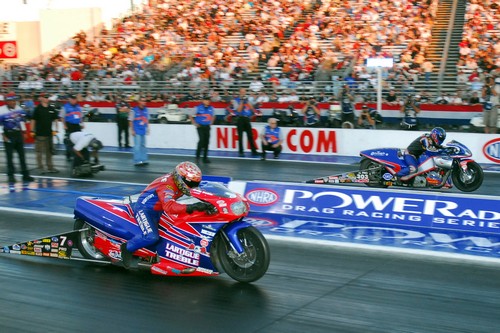TECH CHANGES TO NHRA PSM
Mon, 2006-11-20 21:31


The NHRA has released additional changes to Pro Stock Motorcycle for 2007 that affect four-valve applications. Following is a summary of new rules for a 101-cid, 4-valve, 4-cylinder engine combination in Pro Stock Motorcycle. With these changes, all existing 4-valve engine combinations (i.e., 1994 and newer at 87.2 cid, and older 4 valve engines at 79 cid) in the NHRA Rulebook are deleted, and all engines must be 2000 model year or newer, and NHRA accepted. These changes are effective Jan. 1, 2007.
ENGINEMaximum Displacement 1,655 cc (101.0 cid)
Maximum Bore Spacing 100.0 mm (3.937 inches)
4 valves per cylinder
1 spark plug per cylinder on 4 valve applications
Turbocharger, supercharger and/or nitrous oxide prohibited (same as all engines in Pro Stock Motorcycle)
CASE
All cases must be NHRA accepted
Case must be an OEM-production casting, or a casting or machined billet part based on the production design
Only those cases submitted by the OEM manufacturer will be considered for acceptance
Modifications to any accepted case are prohibited except for repair purposes
Case must be identified with manufacturer’s part/casting number
CYLINDER BLOCK
If cylinder block is separate from engine case, then either the OEM production block or an NHRA-accepted cylinder block is permitted
Block may be cast or machined billet
Only those cylinder blocks submitted by the OEM manufacturer will be considered for acceptance
If the cylinder block is integral to engine case, modifications are only permitted in the bore area; i.e. to enlarge bore(s) or move bore spacing
All cylinder blocks must be identified with manufacturer’s name
CYLINDER HEAD
All heads must be NHRA accepted
Head may be an OEM production casting, or a casting or machined billet part based on the production design
Only those heads submitted by the OEM manufacturer will be considered for acceptance
Chambers may be modified to accommodate bore spacing of block
Head must be identified with manufacturer’s part/casting number
CAMSHAFT(S)/VALVE TRAIN
OEM valve angles +/- 2 degrees mandatory
As with all engines in Pro Stock Motorcycle, variable cam timing devices and/or gear drives are prohibited
Cam(s) must be driven by chain or belt only
Production, cam drive location mandatory
Only conventional coil spring type valve train permitted; pneumatic or other type valvetrains prohibited
CRANKSHAFT
One-piece, steel crankshaft with conventional journal bearings, mandatory
MATERIALS
Unless otherwise noted, all moving engine components are restricted to aluminum, steel, iron, titanium, or other conventional alloys
Magnesium, carbon fiber, Kevlar, ceramics, composites, beryllium or other exotic materials prohibited
TRANSMISSION
Any transmission with maximum 6 forward speeds, minimum 4 forward speeds, permitted
Transmission case must be integral with cast or machined billet engine case
WEIGHT
Minimum weight, motorcycle plus rider, 615 pounds
All other Pro Stock Motorcycle class rules and regulations apply. Please consult 2007 NHRA Rulebook for a complete listing.
Categories:




































